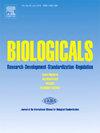Molecular characteristics of feline coronavirus in South Korea, 2016–2023
IF 1.5
4区 生物学
Q4 BIOCHEMICAL RESEARCH METHODS
引用次数: 0
Abstract
Feline coronavirus is highly contagious and ubiquitous in cat populations. FCoV is classified into two serotypes, types I and II, each including two biotypes, feline enteric coronavirus (FECV) and feline infectious peritonitis virus (FIPV)In this study, FCoV detected in samples collected by the Animal and Plant Quarantine Agency from 2016 to 2023, and analyzed genetic diversity of FCoV for currently circulation in Korea. In a total of 925 cats, FCoV was detected in 294 cats (31.8 %). Among the 73 cases with a final diagnosis, 47.9 % (35/73) were finally found to be FIPV, and 52.1 % (38/73) were confirmed to be FECV. Of the 294 FCoV-positive cases, 24 partial S genes were successfully sequenced. Partial S2 subunit sequencing indicated that types I and II accounted for 91.7 % (22/24) and 8.3 % (2/24) of the cases, respectively. One case, 23D103, contained a different six-nucleotide deletion in the S gene. Phylogenetic analysis of types I and II showed clear discrimination based on the S gene. Types I and II also exhibited 63.2–99.8 % nucleotide acid homology with the S gene of the reference strains. This study provides updated information regarding the current infection status and molecular characteristics of FCoV in Korea.
2016-2023年韩国猫冠状病毒分子特征
猫冠状病毒具有高度传染性,在猫群中普遍存在。FCoV分为I型和II型两种血清型,每一种血清型包括猫肠道冠状病毒(FECV)和猫感染性腹膜炎病毒(FIPV)两种生物型。本研究利用2016年至2023年在动植物检疫机关采集的样本中检测到的FCoV,分析了目前在韩国流行的FCoV的遗传多样性。在925只猫中,检出FCoV的有294只(31.8%)。最终确诊的73例病例中,最终确诊FIPV的占47.9%(35/73),确诊FECV的占52.1%(38/73)。在294例fcov阳性病例中,成功测序了24个部分S基因。部分S2亚基测序结果显示,ⅰ型和ⅱ型分别占91.7%(22/24)和8.3%(2/24)。其中一个病例23D103在S基因中含有不同的6个核苷酸缺失。I型和II型的系统发育分析显示基于S基因的明显区分。I型和II型与参比菌株S基因的核苷酸同源性为63.2 ~ 99.8%。本研究提供了有关韩国FCoV感染现状和分子特征的最新信息。
本文章由计算机程序翻译,如有差异,请以英文原文为准。
求助全文
约1分钟内获得全文
求助全文
来源期刊

Biologicals
生物-生化研究方法
CiteScore
3.70
自引率
0.00%
发文量
39
审稿时长
48 days
期刊介绍:
Biologicals provides a modern and multidisciplinary international forum for news, debate, and original research on all aspects of biologicals used in human and veterinary medicine. The journal publishes original papers, reviews, and letters relevant to the development, production, quality control, and standardization of biological derived from both novel and established biotechnologies. Special issues are produced to reflect topics of particular international interest and concern.Three types of papers are welcome: original research reports, short papers, and review articles. The journal will also publish comments and letters to the editor, book reviews, meeting reports and information on regulatory issues.
 求助内容:
求助内容: 应助结果提醒方式:
应助结果提醒方式:


